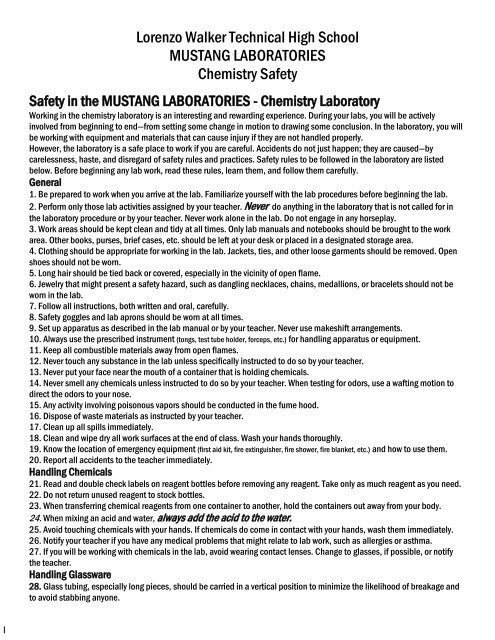Create successful ePaper yourself
Turn your PDF publications into a flip-book with our unique Google optimized e-Paper software.
Lorenzo Walker Technical High School<br />
MUSTANG LABORATORIES<br />
Chemistry Safety<br />
Safety in the MUSTANG LABORATORIES - Chemistry Laboratory<br />
Working in the chemistry laboratory is an interesting and rewarding experience. During your labs, you will be actively<br />
involved from beginning to end—from setting some change in motion to drawing some conclusion. In the laboratory, you will<br />
be working with equipment and materials that can cause injury if they are not handled properly.<br />
However, the laboratory is a safe place to work if you are careful. Accidents do not just happen; they are caused—by<br />
carelessness, haste, and disregard of safety rules and practices. Safety rules to be followed in the laboratory are listed<br />
below. Before beginning any lab work, read these rules, learn them, and follow them carefully.<br />
General<br />
1. Be prepared to work when you arrive at the lab. Familiarize yourself with the lab procedures before beginning the lab.<br />
2. Perform only those lab activities assigned by your teacher. Never do anything in the laboratory that is not called for in<br />
the laboratory procedure or by your teacher. Never work alone in the lab. Do not engage in any horseplay.<br />
3. Work areas should be kept clean and tidy at all times. Only lab manuals and notebooks should be brought to the work<br />
area. Other books, purses, brief cases, etc. should be left at your desk or placed in a designated storage area.<br />
4. Clothing should be appropriate for working in the lab. Jackets, ties, and other loose garments should be removed. Open<br />
shoes should not be worn.<br />
5. Long hair should be tied back or covered, especially in the vicinity of open flame.<br />
6. Jewelry that might present a safety hazard, such as dangling necklaces, chains, medallions, or bracelets should not be<br />
worn in the lab.<br />
7. Follow all instructions, both written and oral, carefully.<br />
8. Safety goggles and lab aprons should be worn at all times.<br />
9. Set up apparatus as described in the lab manual or by your teacher. Never use makeshift arrangements.<br />
10. Always use the prescribed instrument (tongs, test tube holder, forceps, etc.) for handling apparatus or equipment.<br />
11. Keep all combustible materials away from open flames.<br />
12. Never touch any substance in the lab unless specifically instructed to do so by your teacher.<br />
13. Never put your face near the mouth of a container that is holding chemicals.<br />
14. Never smell any chemicals unless instructed to do so by your teacher. When testing for odors, use a wafting motion to<br />
direct the odors to your nose.<br />
15. Any activity involving poisonous vapors should be conducted in the fume hood.<br />
16. Dispose of waste materials as instructed by your teacher.<br />
17. Clean up all spills immediately.<br />
18. Clean and wipe dry all work surfaces at the end of class. Wash your hands thoroughly.<br />
19. Know the location of emergency equipment (first aid kit, fire extinguisher, fire shower, fire blanket, etc.) and how to use them.<br />
20. Report all accidents to the teacher immediately.<br />
Handling Chemicals<br />
21. Read and double check labels on reagent bottles before removing any reagent. Take only as much reagent as you need.<br />
22. Do not return unused reagent to stock bottles.<br />
23. When transferring chemical reagents from one container to another, hold the containers out away from your body.<br />
24. When mixing an acid and water, always add the acid to the water.<br />
25. Avoid touching chemicals with your hands. If chemicals do come in contact with your hands, wash them immediately.<br />
26. Notify your teacher if you have any medical problems that might relate to lab work, such as allergies or asthma.<br />
27. If you will be working with chemicals in the lab, avoid wearing contact lenses. Change to glasses, if possible, or notify<br />
the teacher.<br />
Handling Glassware<br />
28. Glass tubing, especially long pieces, should be carried in a vertical position to minimize the likelihood of breakage and<br />
to avoid stabbing anyone.




